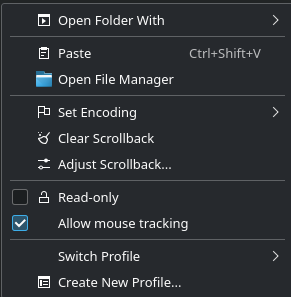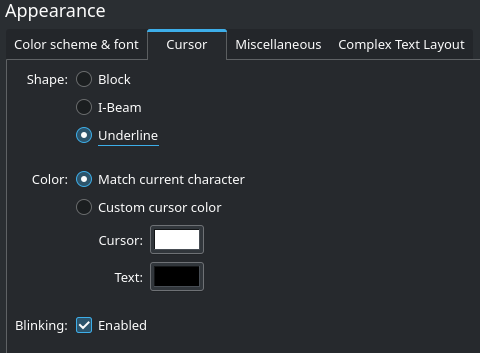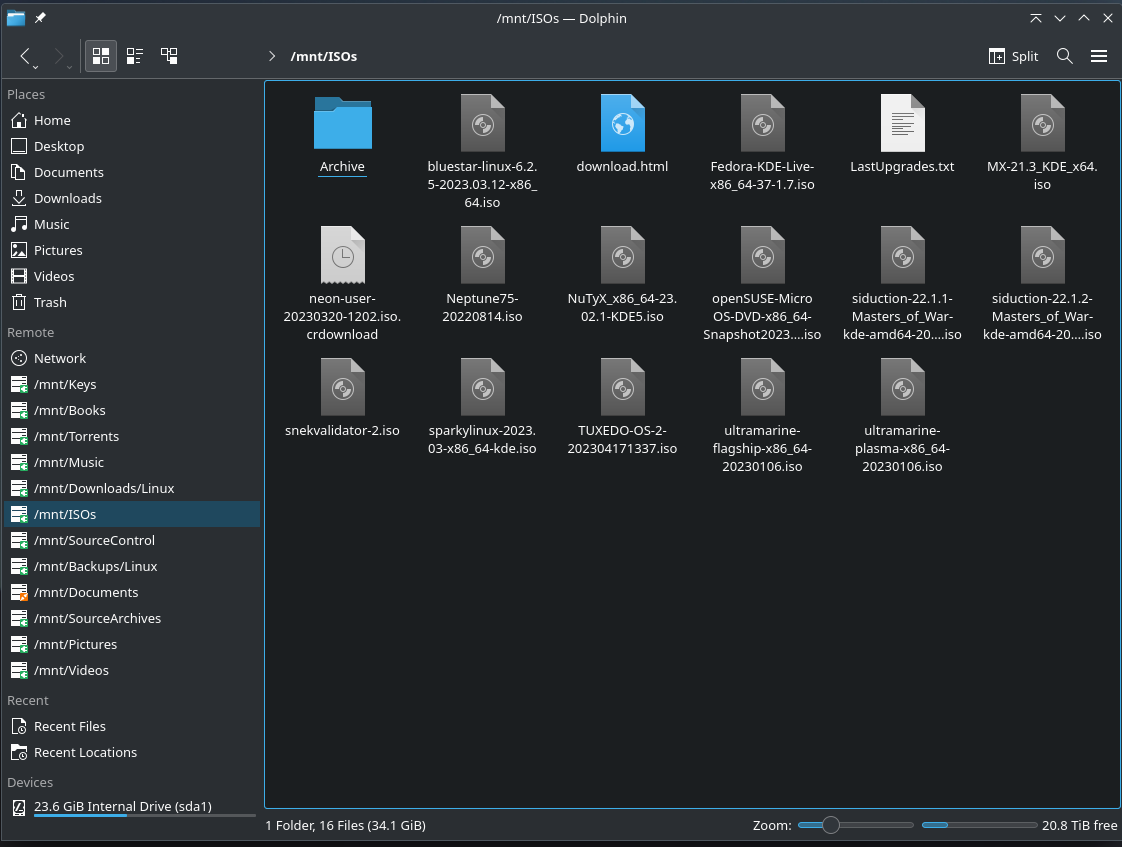Tuxedo OS, cont.
CONFIGURATION, cont.
After making the necessary System Settings changes, I like to fire up a terminal and continue with configuring the computer. This process usually requires the file manager, too, so I set up Dolphin in the workspace next to the one that contains the terminal.
Konsole (and nearly any other terminal emulator) starts out with a font that's way too small on a HD screen, so the first thing I do is right-click on the terminal screen and click on the option to create a new profile.

In the dialog that pops up, in the General settings, you can provide a name for the new profile (I like "Shell") and make it the default profile.

And in the Appearance section, I click to change the font, which brings up this dialog. On a HD laptop screen, a size of 12 or 13 is about right, depending on whether you use the computer on your lap or a table, and how old your eyes are.

Back in the original Appearance section is where you can change the cursor to one you like. I find a blinking underline works well for me, so that's what I set there.

INITIAL CONFIGURATION SOFTWARE
There's no point in going any father here without doing an update. So I use sudo apt update to discover that there are 230 packages that can be upgraded, followed by sudo apt dist-upgrade -y to upgrade them. When that command is done, because there were lots of system files included in the update, I finish with a reboot. Sadly, even after the reboot, the wonderful nala wrapper for apt doesn't exist yet in Tuxedo OS.
Next, I use Nautilus to navigate to my NAS and do two things there. I copy my bashrcAdditions-apt file and paste it into my home folder. This file contains a list of my macros (aliases) that simplify doing tasks like backups, updates, and others. Then I copy a file containing additions for /etc/fstab to mount my NAS shares. I won't illustrate these steps here, because they wouldn't be of interest to most folks reading this.
Then I return to the terminal to load software that I'll want to use during my exploration of Tuxedo OS. That will include micro, the very best command-line editor, nfs-common, to enable me to fetch my shares from the NAS, several solitaire games. Thunderbird is also in the repository, so I'll include that, but Vivaldi is not. To get that, I'll need to use Firefox to fetch its .dev installer file from Vivaldi.com.
I use micro to edit the ./.bashrc and /root/.bashrc files to load my bashrcAdditions-apt file whenever a terminal is launched. I'll illustrate that here, since others might want to use this method with their own aliases. As you might recall, I previously copied that file to my /home folder. The source command looks like this:

I place it near the beginning of each file, right after the test to be sure a human is running the terminal, but I doubt if it matters much where it's placed. Loading my aliases like this makes it easy to add new ones to that file later, or to fix bugs, and not need to do that in two places.
My final edit (for now) is to add the file of NAS shares (that I used Nautilus to fetch) to the end of my /etc/fstab file. Since this wouldn't interest most folks, I'll skip the details, but if it turns out that anyone needs to access remote folders, and IS interested, let me know and I'll document the process separately. Basically what I'm going to do is add those lines to /etc/fstab, run the mount -a command to generate a list of errors about missing folders. That list reminds me of what folders (mount points) I need to create in /mnt. Then I create the folders with a mkdir command, and run the mount -a command one last time.
If I made no errors during all that, Nautilus now includes a list of all those shares, and allows easy access to them. At this point, Tuxedo OS, like Solus, Sparky, Siduction, Ultramarine, and several others, allows clicking on one of these shares to display and access their contents, like the ISOs share shown here.

Now, I usually take this one step farther -- I delete all the folders from my home folder except Desktop, and replace them with symbolic links to these shares, for example: ln -s /mnt/Documents /home/jerry.
That's as far as I want to go with this for now. I have a lot of software to install, then I'll work with this VM for a while. In the next message I'll provide a summary of the time I've spent with Tuxedo OS and my conclusion.